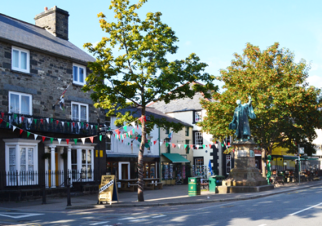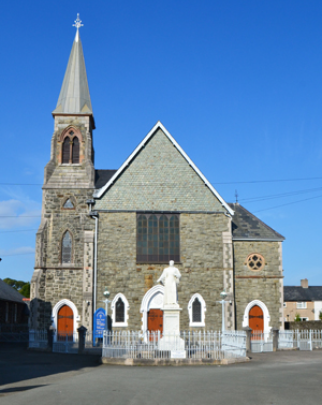Bala is a historic market town founded by the Normans
in the 12th century.
The Castle Mound was erected during this period together with the parallel pattern of
the town’s streets. Roger de Mortimer’s aim in establishing the town was to calm the
hostile population of the Penllyn area, which is the district surrounding the lake.
At the same time the town was granted a charter and permission to create the role of
the mayor - a tradition we are proud to uphold today!
The name Bala indicates where a river flows from the lake – in this case, it is the River
Dee which flows from the lake. Llyn Tegid (the correct name for “Bala Lake”) is the
largest natural lake in Wales. The lake was formerly called "Pimblemere" - a mis-
pronunciation of "Pum Plwy - Five Parishes’ - mere" according to some.
There are many examples of the town and area’s historical importance – from here, for instance, the Roman Emperor Julius Caesar
obtained his army’s horses.
In 1485 Henry Tudor’s army marched through the area on his journey to the Battle of Bosworth. Rhys ap Meredudd joined him and,
following Henry’s victory, the family earned considerable privileges from the new king,
Henry VII, which in turn led to the establishment of the Rhiwlas estate .
The wool industry was important to the town, especially the tradition of knitting socks -
George III insisted on wearing Bala knitted stockings to relieve his rheumatism.
Bala has had a profound influence on Wales and further afield: the religious revival
experienced here led to the establishment of The Bible Society after the Rev. Thomas
Charles was inspired by Mary Jones’s long barefoot journey to Bala to obtain a Welsh
Bible.
In this town also Betsi Cadwaladr was born. She journeyed to the Crimea to nurse and
was very instrumental in improving conditions for the wounded soldiers.
On the outskirts of town is the home of Michael D Jones who was at the forefront in
establishing the Welsh settlement in Patagonia.
Tom Ellis, who was MP for Meirionnydd and chief whip of the Liberal Party, is
commemorated in a striking sculpture on the High Street by the renowned scultor, Sir
W Gascombe John. In the Henblas Centre nearby of Tom Ellis by the same sculptor can
be seen a bust.
The Henblas Centre is home to Bala Town Council and the Community Councils of the
parishes of Penllyn, members of which work together to ensure high quality services for
the district’s residents



Cyngor Tref Y
Bala
Town Council
Cynghorau Penllyn Councils © 2025 Website designed and maintained by H G Web Designs


Bala is a historic market town founded by
the Normans in the 12th century.
The Castle Mound was erected during this period together with the
parallel pattern of the town’s streets. Roger de Mortimer’s aim in
establishing the town was to calm the hostile population of the
Penllyn area, which is the district surrounding the lake.
At the same time the town was granted a charter and permission
to create the role
of the mayor - a
tradition we are
proud to uphold
today!
The name Bala
indicates where
a river flows from
the lake – in this
case, it is the
River Dee which
flows from the
lake. Llyn Tegid
(the correct name for “Bala Lake”) is the largest natural lake in
Wales. The lake was formerly called "Pimblemere" - a mis-
pronunciation of "Pum Plwy - Five Parishes’ - mere" according to
some.
There are many examples of the town and area’s historical
importance – from here, for instance, the Roman Emperor Julius
Caesar obtained his army’s horses.
In 1485 Henry Tudor’s army marched through the area on his
journey to the Battle of Bosworth. Rhys ap Meredudd joined him
and, following Henry’s victory, the family earned considerable
privileges from the new king, Henry VII, which in turn led to the
establishment of the Rhiwlas estate .
The wool industry was important to the town, especially the
tradition of knitting socks - George III insisted on wearing Bala
knitted
stockings to
relieve his
rheumatism.
Bala has had a
profound
influence on
Wales and
further afield:
the religious
revival
experienced
here led to the
establishment of
The Bible Society
after the Rev.
Thomas Charles
was inspired by
Mary Jones’s
long barefoot
journey to Bala
to obtain a
Welsh Bible.
In this town also Betsi Cadwaladr was born. She journeyed to the
Crimea to nurse and was very instrumental in improving conditions
for the wounded soldiers.
On the outskirts of town is the home of Michael D Jones who was
at the forefront in establishing the Welsh settlement in Patagonia.
Tom Ellis, who was MP for Meirionnydd and chief whip of the
Liberal Party, is commemorated in a striking sculpture on the High
Street by the renowned scultor, Sir W Gascombe John. In the
Henblas Centre nearby of Tom Ellis by the same sculptor can be
seen a bust.
The Henblas Centre is home to Bala Town Council and the
Community Councils of the parishes of Penllyn, members of which
work together to ensure high quality services for the district’s
residents


Cyngor Tref Y
Bala
Town Council


Cynghorau Penllyn Councils © 2025
Website designed and maintained by H G Web Designs















